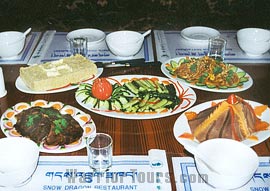Minority Cuisines
Besides the eight cuisines, there are other various minority foods in China due to its vast territory and multitude of nationalities, including Hui cuisine, Tibetan cuisine, Miao cuisine, Mongolian cuisine and Zhuang cuisine.
![]() Hui Cuisine
Hui Cuisine
Well-known throughout China, Hui Cuisine also named Muslim food is both nutritious and distinctive. Uygur food is also a part of Muslim food, and the most famous foods of the Uygur people are finger rice, nang, Mutton shashlik, roasted whole lamb and so on. Hui Cusine, called Qingzhen (pure and true) in Chinese is refined in the quality and selection of the materials. The Hui minority prefer to eat ruminant animal meat, vegetarian animals and poultry which must be butchered by a Muslim priest, called Ahong in Chinese. The Hui people also live on cooked wheaten food which is used to indulge their guests and celebrate the various Chinese festivals. Beef and mutton also comprise a great part in their life. Besides, tea served in a set of cups is also a customary staple of the Hui people's diet. The common characteristics of the Hui cuisine and of their restaurants, food stands and tea houses are the Muslim's boards or blue cloth strips hung in front of the doors, and also all the packages of the Hui foods are printed with Muslim characters, patterns or scriptures.
However, the Hui people have their own serious food taboos, they don't eat the meat of pig, dog, mule, horse, donkey, cat, mouse or animal's blood. In addition, they are forbidden to drink alcohol. The Hui Minority's most famous cuisine includes steamed lamb, lamb eaten with hands, fried beef, deep-fried food, Hand-Pulled Noodles with Beef, Xian Mutton and Bread Pieces in Soup and so on.

![]() Tibetan Cuisine
Tibetan Cuisine
Tibetan people live on rice, flour and qingke (highland barley). Mutton, beef, pork and chicken are the ordinary meat they usually eat, while the vegetables they eat are potatoes and carrots. Their foods are usually greasy and strongly seasoned, rich in protein and calories. Salt, garlic and green Chinese onion are the only seasonings they use. Roasting, frying and steaming are the most common cooking methods.
There are more than 60 varieties of typical Tibetan dishes, among which the most famous ones are food made of Qingke, qingke wine, zamba, cheese, butter tea and milk tea. In addition, rice with milk and meat dumplings in sparerib soup are also popular. The traditional feast to entertain guests is made up of milk tea, steamed stuffed bun, mutton eaten with fingers, assorted vegetables and yogurt.
![]() Miao Cuisine
Miao Cuisine
Miao people live on rice, and they also like deep-fried foods like deep-fried stuffed buns. The meat they eat is mostly from the poultry they raise, and the most common vegetables they eat are soybeans, melons, green vegetables and carrots. Most Miao people are especially good at cooking dishes made of soybeans. Besides animal oil, they also eat tea oil and vegetable oil. Hot pepper is the main seasoning they use, and there is a saying in some places that 'It can't be a real dish without hot pepper.'
Most Miao people like to eat sour dishes, and every family has sour soup which is made through fermenting rice or tofu water in a crock for three to five days. Sour soup can be used for cooking meat, fish or all kinds of vegetables. In order to keep the food in good condition, Miao people usually salt the vegetables, chicken, fish and meat in a crock. The Miao people in western Hunan Province are very hospitable. Butter tea is a must which they use for entertaining their guests who have to drink four bowls without stopping, representing being alive and well in all four seasons.

However, Miao people have their taboos. Whenever it is dry and doesn't rain for a long time or people are suffering from illness, Miao people will kill cattle or pig to offer sacrifices to the Thor, and they can only eat the boiled food without salt. In addition, Miao people are forbidden to eat the meat of fish, shrimp, chicken, duck, turtle and crab, but they can eat pork, beef and mutton during days of fasting.
![]() Mongolian Cuisine
Mongolian Cuisine
Mongolian Cuisine mainly includes dairy also named 'white food' and beef, mutton and other meat called 'red food'. Meanwhile, parched rice also plays an equal role along with the 'white food' and the 'red food' in Mongolian people's daily diet. Besides cow's milk, Mongolian people also drink the milk of goat, horse, deer and camel. Only a small part of the milk is made into fresh milk beverages, and the majority part is manufactured into milk products such as cheese, dried milk cake, cream, milk powder and so on. Milk products are the most common foods used to treat guests, and if the guest is a child, the host will put the cream on his forehead to show the host's best wishes.
Mongolian people often eat beef and the meat of sheep, goats, camels and horses. They have over 70 common mutton dishes such as roasted whole lamb, fried lamb tripe, mutton eaten with fingers, deep-fried mutton and so on. They usually eat beef in winters, and there is also beef soup, baked beef and braised beef. Some experienced chefs can even cook the tendons of the sheep, cattle, deer and horse into some medicinal foods. In addition, Mongolian people also dry or salt the beef and mutton for storage purposes.
![]() Zhuang Cuisine
Zhuang Cuisine
As an agricultural ethnic group, Zhuang people do not only plant rice, corn, soybeans, potatoes, melons and fruits, but also raise pig, cattle, goat, chicken, duck and other poultries. As a result, Zhaung people have many distinctive foods, including tender boiled chicken with soy sauce, stewed snails, five-color glutinous rice, rice rolled in lettuce, steamed rice in bamboo mug and so on.

